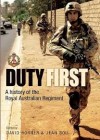Book Review - Duty First: A History of the Royal Australian Regiment (2nd edition)
Duty First: A History of the Royal Australian Regiment (2nd edition)
Wriitten by: David Horner and Jean Bou (eds.),
Allen & Unwin, Sydney, 2008, 526 pp.
Reviewed by: Karl James
In the days following the end of the Second World War three new Australian infantry battalions were raised. The 65th Battalion opened its headquarters at Balikpapan, on Borneo’s east coast, in the Netherlands East Indies, on 11 October 1945. Two weeks later, on 26 October, the 66th Battalion was formed on Labuan in northern Borneo, while in New Guinea and on Bougainville personnel were being selected to form the 67th Battalion. These battalions, whose initial members were veterans of the campaigns in the Middle East and Pacific, were raised as part of Australia’s contribution to the British Commonwealth Occupation Force for Japan. They were also to become the genesis of the Royal Australian Regiment (RAR).
With the formation of the Australian Regular Army, on 23 November 1948 the 65th, 66th and 67th Battalions became the 1st, 2nd and 3rd Battalions of the Australian Regiment. Four months later, on 10 March 1949, it was announced that the regiment had been granted the title ‘Royal’ by His Majesty King George VI. The regiment has loyally served Australia in war and peace for six decades. During this time it has won battle honours for the Korean and Vietnam wars, and its battalions have seen active service in other parts of Asia, Africa and the Middle East. The regiment’s history is so closely associated with the history of the post-war Australian Army that at times it would seem that they are interchangeable.
This long and distinguished history is skilfully and succinctly told here in Duty First—the regiment’s official history. Edited by David Horner and Jean Bou, the book features contributions from some of the Army’s most prominent soldier-scholars, including Bob Breen, Peter Pedersen and Craig Stockings, almost all of whom have served with the regiment. The book also contains reminisces from the late Sir Frank Hassett and other distinguished officers. Duty First is an authoritative history that clearly narrates the regiment’s service at home and abroad. It is an invaluable reference.
This current edition is an updated version of the earlier 1990 edition, with two new chapters on the regiment’s participation in United Nations peacekeeping missions and current conflicts. In order to accommodate the new chapters, the older chapters were reduced in length, as the publisher demanded that the new edition could be no longer than the original. This is unfortunate. John Blaxland’s chapter covering the period from 1999 to 2006, easily the regiment’s most taxing time since Vietnam, with multiple deployments to East Timor, Afghanistan, Iraq and the Solomon Islands, should have extended over two chapters, to allow for a more detailed discussion. Nor is there the space or scope to assess the challenges that confront the regiment, such as, for example, the criticisms of the current operations where it has been recently argued that the Special Forces have superseded the infantry’s traditional role.1
There is also little room for ‘colour’ in this new edition. An anecdote by Harry Smith of a comical parade in front of the battalion’s new commander officer in Malaya during the late 1950s provides a tantalising taste of the lighter side of regimental life, while Pederson’s description of young regular officers who joined the regiment in the 1970s, too late for service in Vietnam, is telling of the frustrations experienced by many during those ‘silent years’ when there was little chance of overseas deployment. Moments such as these hint at the regiment’s rich social history, but they are few and far between. Duty First is a top down history, written from the level of the battalion commander and the regimental sergeant major.
Unit and corps histories are often written for former members, and usually hold little interest to general readers. This is not the case with Duty First, however. This book will appeal to those interested in Australian military history. Members of the regiment, both past and present, will likewise feel proud of their achievements. The bravery, skill and versatility of those officers and soldiers who have served in the regiment are repeatedly highlighted throughout the book. They have always met the challenge of their motto and put ‘duty first’.
Endnote
1 See Jim Hammett, ‘We Were Soldiers Once ... The Decline of the Royal Australian Infantry Corps?’, Australian Army Journal, Vol. V, No. 1, pp. 39–50.



